初中英语语法情态动词用法大全
- 格式:doc
- 大小:37.10 KB
- 文档页数:2
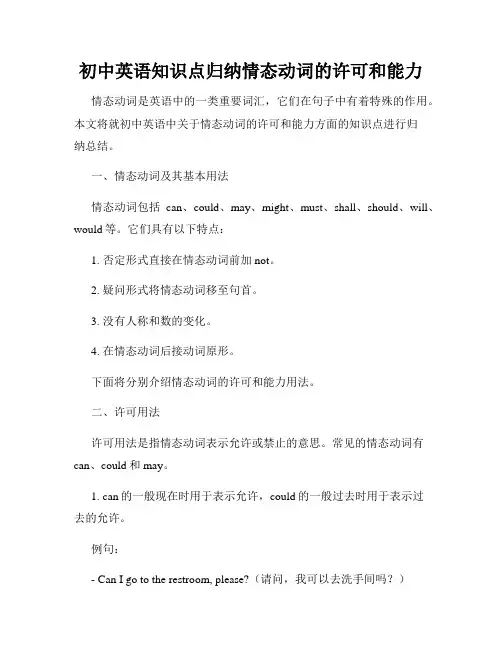
初中英语知识点归纳情态动词的许可和能力情态动词是英语中的一类重要词汇,它们在句子中有着特殊的作用。
本文将就初中英语中关于情态动词的许可和能力方面的知识点进行归纳总结。
一、情态动词及其基本用法情态动词包括can、could、may、might、must、shall、should、will、would等。
它们具有以下特点:1. 否定形式直接在情态动词前加not。
2. 疑问形式将情态动词移至句首。
3. 没有人称和数的变化。
4. 在情态动词后接动词原形。
下面将分别介绍情态动词的许可和能力用法。
二、许可用法许可用法是指情态动词表示允许或禁止的意思。
常见的情态动词有can、could和may。
1. can的一般现在时用于表示允许,could的一般过去时用于表示过去的允许。
例句:- Can I go to the restroom, please?(请问,我可以去洗手间吗?)- Could I borrow your pen, please?(请问,我可以借用你的笔吗?)2. may的一般现在时常用于正式场合或向上级征求许可。
例句:- May I use your phone, sir?(请问,我可以用一下您的手机吗,先生?)- May I join the meeting, boss?(请问,我可以参加会议吗,老板?)三、能力用法能力用法是指情态动词表示能力或可能性。
常见的情态动词有can、could、may和might。
1. can和could表示一般的能力或可能性。
例句:- I can swim in the pool.(我会游泳。
)- He could speak English fluently when he was young.(他年轻时可以流利地说英语。
)2. may和might表示较可能或较不可能的可能性。
例句:- It may rain tomorrow.(明天可能会下雨。
)- She might be late for the meeting.(她可能会迟到会议。
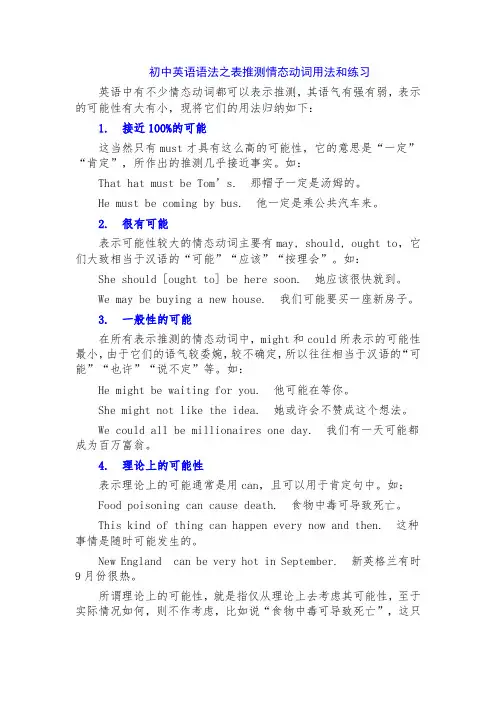
初中英语语法之表推测情态动词用法和练习英语中有不少情态动词都可以表示推测,其语气有强有弱,表示的可能性有大有小,现将它们的用法归纳如下:1. 接近100%的可能这当然只有must才具有这么高的可能性,它的意思是“一定”“肯定”,所作出的推测几乎接近事实。
如:That hat must be Tom’s. 那帽子一定是汤姆的。
He must be coming by bus. 他一定是乘公共汽车来。
2. 很有可能表示可能性较大的情态动词主要有may, should, ought to,它们大致相当于汉语的“可能”“应该”“按理会”。
如:She should [ought to] be here soon. 她应该很快就到。
We may be buying a new house. 我们可能要买一座新房子。
3. 一般性的可能在所有表示推测的情态动词中,might和could所表示的可能性最小,由于它们的语气较委婉,较不确定,所以往往相当于汉语的“可能”“也许”“说不定”等。
如:He might be waiting for you. 他可能在等你。
She might not like the idea. 她或许会不赞成这个想法。
We could all be millionaires one day. 我们有一天可能都成为百万富翁。
4. 理论上的可能性表示理论上的可能通常是用can,且可以用于肯定句中。
如:Food poisoning can cause death. 食物中毒可导致死亡。
This kind of thing can happen every now and then. 这种事情是随时可能发生的。
New England can be very hot in September. 新英格兰有时9月份很热。
所谓理论上的可能性,就是指仅从理论上去考虑其可能性,至于实际情况如何,则不作考虑,比如说“食物中毒可导致死亡”,这只是理论上的一种推断,至于某人某次食物中毒了,他是否会死亡,则不在考虑之列,所以说,这种推测是非常“宏观”的!5. 表示对过去情况作推测如果表示对已经发生的情况作推测,不能用“情态动词+动词原形”,也不能用“情态动词的过去式+动词原形”,而是要使用“情态动词+动词完成式”。
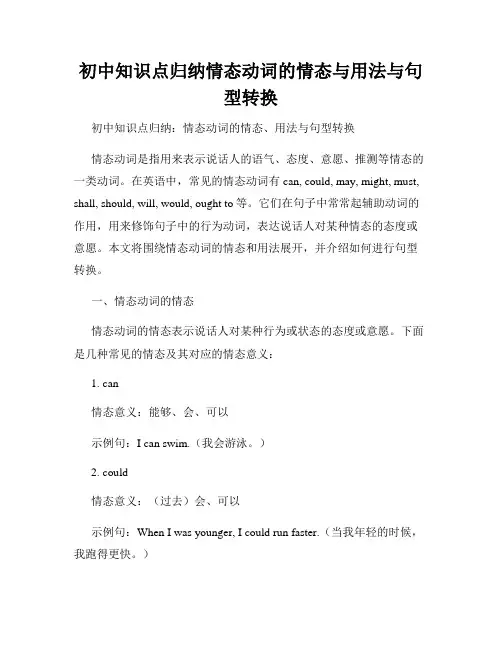
初中知识点归纳情态动词的情态与用法与句型转换初中知识点归纳:情态动词的情态、用法与句型转换情态动词是指用来表示说话人的语气、态度、意愿、推测等情态的一类动词。
在英语中,常见的情态动词有can, could, may, might, must, shall, should, will, would, ought to等。
它们在句子中常常起辅助动词的作用,用来修饰句子中的行为动词,表达说话人对某种情态的态度或意愿。
本文将围绕情态动词的情态和用法展开,并介绍如何进行句型转换。
一、情态动词的情态情态动词的情态表示说话人对某种行为或状态的态度或意愿。
下面是几种常见的情态及其对应的情态意义:1. can情态意义:能够、会、可以示例句:I can swim.(我会游泳。
)2. could情态意义:(过去)会、可以示例句:When I was younger, I could run faster.(当我年轻的时候,我跑得更快。
)3. may情态意义:可能、可以示例句:May I go to the restroom?(我可以去洗手间吗?)4. might情态意义:可能、也许、或许示例句:He might be late for the meeting.(他可能会迟到会议。
)5. must情态意义:必须、肯定示例句:You must finish your homework before going out.(你在外出之前必须完成作业。
)6. shall情态意义:将会、应该示例句:Shall we go for a walk?(我们去散步好吗?)7. should情态意义:应该、应当示例句:You should apologize for what you said.(你应该为你所说的道歉。
)8. will情态意义:将要、愿意、要示例句:I will help you with your project.(我愿意帮你完成项目。
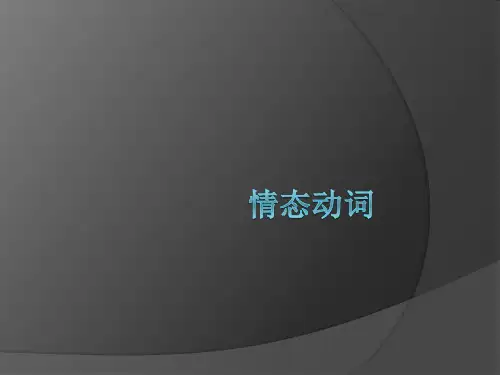
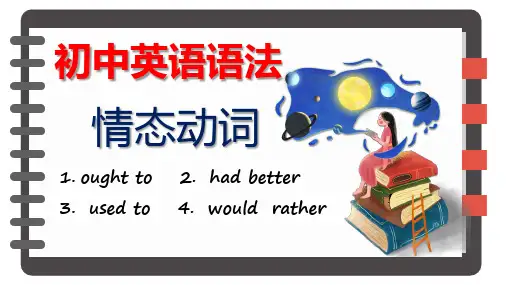
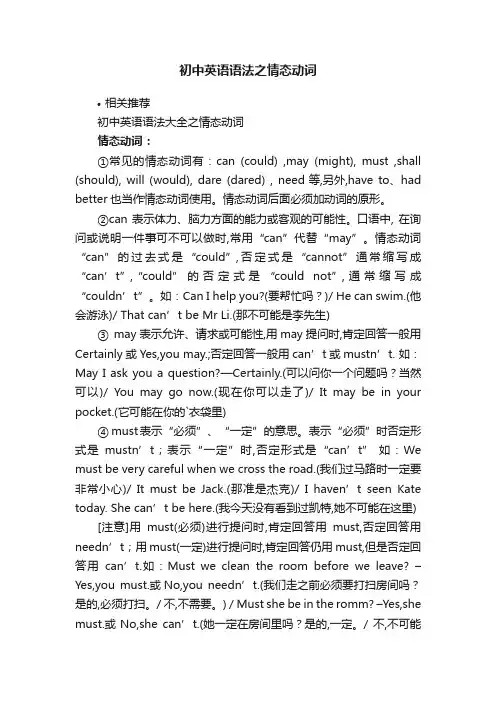
初中英语语法之情态动词•相关推荐初中英语语法大全之情态动词情态动词:①常见的情态动词有:can (could) ,may (might), must ,shall (should), will (would), dare (dared) , need等,另外,have to、had better也当作情态动词使用。
情态动词后面必须加动词的原形。
②can表示体力、脑力方面的能力或客观的可能性。
口语中, 在询问或说明一件事可不可以做时,常用“can”代替“may”。
情态动词“can”的过去式是“could”,否定式是“cannot”通常缩写成“can’t”,“could”的否定式是“could not”,通常缩写成“couldn’t”。
如:Can I help you?(要帮忙吗?)/ He can swim.(他会游泳)/ That can’t be Mr Li.(那不可能是李先生)③ may表示允许、请求或可能性,用may提问时,肯定回答一般用Certainly或Yes,you may.;否定回答一般用can’t或mustn’t. 如:May I ask you a question?—Certainly.(可以问你一个问题吗?当然可以)/ You may go now.(现在你可以走了)/ It may be in your pocket.(它可能在你的`衣袋里)④ must表示“必须”、“一定”的意思。
表示“必须”时否定形式是mustn’t;表示“一定”时,否定形式是“can’t” 如:We must be very careful when we cross the road.(我们过马路时一定要非常小心)/ It must be Jack.(那准是杰克)/ I haven’t seen Kate today. She can’t be here.(我今天没有看到过凯特,她不可能在这里) [注意]用must(必须)进行提问时,肯定回答用must,否定回答用needn’t;用must(一定)进行提问时,肯定回答仍用must,但是否定回答用can’t.如:Must we clean the room before we leave? –Yes,you must.或No,you needn’t.(我们走之前必须要打扫房间吗?是的,必须打扫。
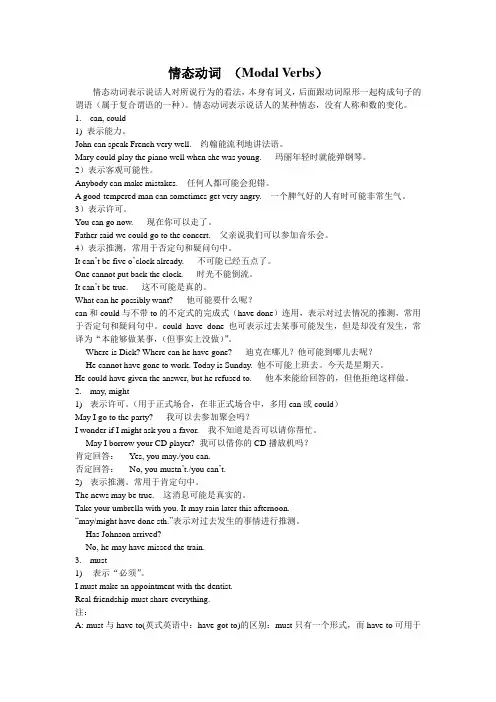
情态动词(Modal Verbs)情态动词表示说话人对所说行为的看法,本身有词义,后面跟动词原形一起构成句子的谓语(属于复合谓语的一种)。
情态动词表示说话人的某种情态,没有人称和数的变化。
1.can, could1)表示能力。
John can speak French very well. 约翰能流利地讲法语。
Mary could play the piano well when she was young. 玛丽年轻时就能弹钢琴。
2)表示客观可能性。
Anybody can make mistakes. 任何人都可能会犯错。
A good-tempered man can sometimes get very angry. 一个脾气好的人有时可能非常生气。
3)表示许可。
You can go now. 现在你可以走了。
Father said we could go to the concert. 父亲说我们可以参加音乐会。
4)表示推测,常用于否定句和疑问句中。
It can’t be five o’clock already. 不可能已经五点了。
One cannot put back the clock. 时光不能倒流。
It can’t be true. 这不可能是真的。
What can he possibly want? 他可能要什么呢?can和could与不带to的不定式的完成式(have done)连用,表示对过去情况的推测,常用于否定句和疑问句中。
could have done 也可表示过去某事可能发生,但是却没有发生,常译为“本能够做某事,(但事实上没做)”。
--- Where is Dick? Where can he have gone? 迪克在哪儿?他可能到哪儿去呢?--- He cannot have gone to work. Today is Sunday. 他不可能上班去。
今天是星期天。
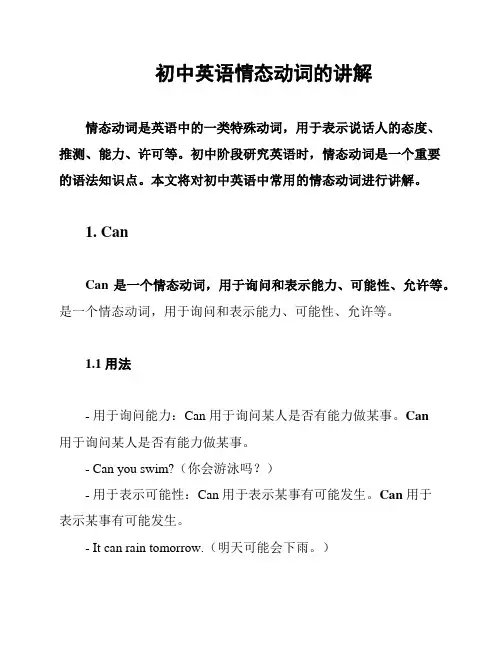
初中英语情态动词的讲解情态动词是英语中的一类特殊动词,用于表示说话人的态度、推测、能力、许可等。
初中阶段研究英语时,情态动词是一个重要的语法知识点。
本文将对初中英语中常用的情态动词进行讲解。
1. CanCan 是一个情态动词,用于询问和表示能力、可能性、允许等。
是一个情态动词,用于询问和表示能力、可能性、允许等。
1.1 用法- 用于询问能力:Can 用于询问某人是否有能力做某事。
Can用于询问某人是否有能力做某事。
- Can you swim?(你会游泳吗?)- 用于表示可能性:Can 用于表示某事有可能发生。
Can用于表示某事有可能发生。
- It can rain tomorrow.(明天可能会下雨。
)- 用于征求允许:Can 用于请求允许做某事。
Can用于请求允许做某事。
- Can I borrow your pen?(我可以借用你的钢笔吗?)1.2 注意事项- 当 Can 用于疑问句时,其后的动词需用原形。
Can用于疑问句时,其后的动词需用原形。
- Can she play the guitar?(她会弹吉他吗?)2. MustMust 是一个情态动词,用于表示必须,义务和推测。
是一个情态动词,用于表示必须,义务和推测。
2.1 用法- 用于表示必须:Must 用于表示某事是必须的。
Must用于表示某事是必须的。
- You must finish your homework before watching TV.(你必须在看电视之前完成作业。
)- 用于表示义务:Must 用于表示某事是责任所在。
Must用于表示某事是责任所在。
- We must obey the rules.(我们必须遵守规则。
)- 用于表示推测:Must 用于表示一种较为确信的推测。
Must用于表示一种较为确信的推测。
- He must be tired after running for so long.(他跑了这么长时间,一定很累了。

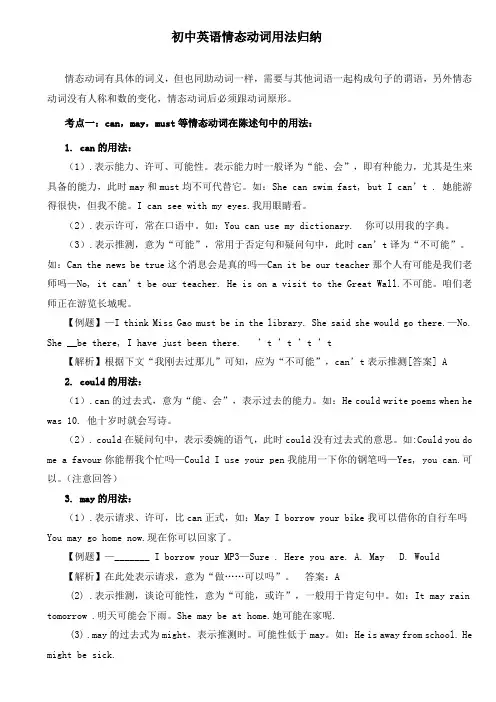
初中英语情态动词用法归纳情态动词有具体的词义,但也同助动词一样,需要与其他词语一起构成句子的谓语,另外情态动词没有人称和数的变化,情态动词后必须跟动词原形。
考点一:can,may,must等情态动词在陈述句中的用法:1. can的用法:(1).表示能力、许可、可能性。
表示能力时一般译为“能、会”,即有种能力,尤其是生来具备的能力,此时may和must均不可代替它。
如:She can swim fast, but I can’t . 她能游得很快,但我不能。
I can see with my eyes.我用眼睛看。
(2).表示许可,常在口语中。
如:You can use my dictionary. 你可以用我的字典。
(3).表示推测,意为“可能”,常用于否定句和疑问句中,此时can’t译为“不可能”。
如:Can the news be true这个消息会是真的吗—Can it be our teacher那个人有可能是我们老师吗—No, it can’t be our teacher. He is on a visit to the Great Wall.不可能。
咱们老师正在游览长城呢。
【例题】—I think Miss Gao must be in the library. She said she would go there.—No. She __be there, I have just been there. ’t ’t ’t ’t【解析】根据下文“我刚去过那儿”可知,应为“不可能”,can’t表示推测[答案] A2. could的用法:(1).can的过去式,意为“能、会”,表示过去的能力。
如:He could write poems when he was 10. 他十岁时就会写诗。
(2). could在疑问句中,表示委婉的语气,此时could没有过去式的意思。
如:Could you do me a favour你能帮我个忙吗—Could I use your pen我能用一下你的钢笔吗—Yes, you can.可以。
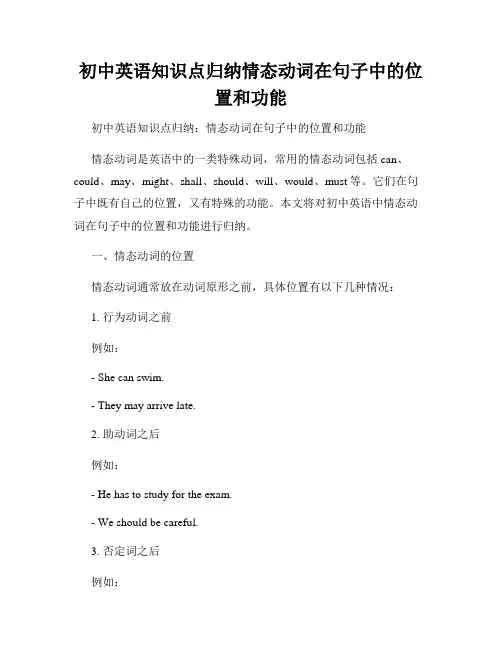
初中英语知识点归纳情态动词在句子中的位置和功能初中英语知识点归纳:情态动词在句子中的位置和功能情态动词是英语中的一类特殊动词,常用的情态动词包括can、could、may、might、shall、should、will、would、must等。
它们在句子中既有自己的位置,又有特殊的功能。
本文将对初中英语中情态动词在句子中的位置和功能进行归纳。
一、情态动词的位置情态动词通常放在动词原形之前,具体位置有以下几种情况:1. 行为动词之前例如:- She can swim.- They may arrive late.2. 助动词之后例如:- He has to study for the exam.- We should be careful.3. 否定词之后例如:- You must not touch the paintings.- They should not play in the street.4. 祈使句中例如:- Can you pass me the salt, please?- Could you please close the door?二、情态动词的功能情态动词在句子中具有以下几种功能:1. 表示能力和能够性情态动词can和could用于表示某人具有做某事的能力,表示"能够"。
may和might也可用于表示可能性,但语气较弱。
例如:- She can speak three languages.- He could run very fast when he was young.- It may rain tomorrow.2. 表示许可和允许情态动词can和may可用于表示许可或允许,意为"可以"。
例如:- Can I use your phone?- May I borrow your pen?3. 表示建议和应该性情态动词should和ought to可用于表示建议或提出应该做某事的观点。
初中英语知识点归纳情态动词的意愿和能力情态动词(Modal Verbs)是英语中一类具有特殊用法的动词,用以表示说话者的意愿、能力、推测、允许或命令等情态。
初中英语学习中,掌握情态动词的意愿和能力用法对于提高语言表达能力至关重要。
本文将对初中英语知识点进行归纳总结,以便同学们更好地掌握情态动词的用法。
一、情态动词的意愿1. Can(能够,会)- 表示能力或允许做某事,通常后接动词原形。
- 例句:I can swim.(我会游泳。
)- 例句:Can I go to the park?(我可以去公园吗?)2. May(可以,可能)- 表示请求或允许做某事。
- 例句:May I use your pen?(我可以用你的钢笔吗?)- 例句:It may rain tomorrow.(明天可能会下雨。
)3. Could(可以,能够)- 过去式形式,表示过去的能力或允许。
- 例句:I could swim when I was five.(我五岁时会游泳。
)- 例句:Could I have a glass of water?(我可以喝一杯水吗?)4. Might(可能)- 表示施予的请求或提出可能的想法。
- 例句:Might I ask you a question?(我可以问你一个问题吗?)- 例句:He might be at home.(他可能在家。
)5. Would(愿意)- 表示征求或表达请求,含有更委婉的口气。
- 例句:Would you like some tea?(你想喝点茶吗?)- 例句:Would you mind closing the window?(你介意关窗户吗?)二、情态动词的能力1. Can(能够)- 表示能力或允许做某事。
- 例句:I can play the piano.(我会弹钢琴。
)- 例句:Can you speak Chinese?(你会说中文吗?)2. Could(能够)- 过去式形式,表示过去的能力或允许。
初中英语情态动词的基本用法讲解1.can (could)1)表示能力,could主要指过去时间。
Two eyes can see more than one. 两只眼比一只眼看得清。
Could the girl read before she went to school? 这女孩上学前能识字吗?2)表示可能(理论上或是逻辑判断上)。
The temperature can fall to –60℃, that is 60℃below freezing.气温可降至—60℃,也就是零下60℃。
He can’t (couldn’t) have enough money for a new car. 他不可能有足够的钱买新车。
You mustn't smoke while you're walking around in the wood. You could start a fire.在林子里走时勿吸烟,那样可能会引起火灾。
3)表示允许。
Can I have a look at your new pen? 我可以看一看你的新钢笔吗?He asked whether he could take the book out of the reading-room.他问他可不可以把书带出阅览室。
4)表惊异、怀疑、不相信等态度。
主要用于否定句、疑问句或感叹句中。
Where can (could) they have gone to? 他们会去哪儿了呢?He can’t (couldn’t) be over sixty. 他不可能超过六十岁。
How can you be so careless? 你怎么这么粗心?5)比较委婉客气地提出问题或陈述看法。
Can (Could) you lend me a hand? 帮我一把好吗?I’m afraid we couldn’t give you an answer today. 恐怕我们今天不能给你答复。
初中英语情态动词用法归纳情态动词有具体的词义,但需要与其他词语一起构成句子的谓语。
情态动词没有人称和数的变化,必须跟动词原形。
本文将介绍can、may、must等情态动词在陈述句中的用法。
考点一:can,may,must等情态动词在陈述句中的用法:1.___的用法:1)表示能力、许可、可能性。
表示能力时一般译为“能、会”,即有种能力,尤其是生来具备的能力。
此时may和must均不能代替它。
例如:She can swim fast。
but I can’t。
我们可以说她能游得很快,但我不能。
I can see with my eyes。
我可以用眼睛看。
2)表示许可,在口语中常用。
例如:___。
你可以使用我的字典。
3)表示推测,意为“可能”,常用于否定句和疑问句中。
此时can’t译为“不可能”。
例如:Can the news be true。
这个消息可能是真的吗?—Can it be our ___。
那个人可能是我们老师吗?—No。
it can’t be our teacher。
He is on a visit to the Great Wall。
不可能。
我们的老师正在游览长城。
例题】—I think Miss Gao must be in the library。
She said she would go there.—No。
She can’t be there。
I have just been there.A。
can’tB。
mustn’tC。
___’tD。
wouldn’t解析】根据下文“我刚去过那儿”可知,应为“不可能”,can’t表示推测。
[答案] A2.could的用法:1)can的过去式,意为“能、会”,表示过去的能力。
例如:He could write poems when he was 10.他十岁时就会写诗。
2)could在疑问句中,表示委婉的语气。
此时could没有过去式的意思。
例如:Could you do me a favour。
初中英语10大情态动词的用法详解,提分18不是梦!赶紧收
藏!
在初中英语学习的过程中,情态动词是英语语法知识中的一个重要知识点,在中考英语中是必考内容。
情态动词表示语气的单词,但是不能独立作谓语,只能和动词原形一起构成谓语。
情态动词用在行为动词前,表示说话人对这一动作或状态的看法或主观设想。
情态动词无人称和数的变化,情态动词后面跟的动词须用原形,否定式构成是在情态动词后面加'not'。
个别情态动词有现在式和过去式两种形式,过去式用来表达更加客气,委婉的语气,时态性不强,可用于过去,现在或将来。
情态动词属非及物动词,故没有被动语态。
下面就是小编今天给大家带来的初中英语情态动词的用法,同学们赶紧来看看吧!。
情态动词 有can (could), may (might), must, have to, shall (should, will (would), dare (dared), need (needed), ought to等。 情态动词无人称和数的变化;不能单独使用,必须与其后的动词原形构成谓语。 情态动词 can 表示能力,意为 “能 会” 表示推测, 意为 “可能”, 常用于否定句和疑问句中 表示请求, 允许, 意为“可以” could 是can 的过去式,意为“能、会”, 表示过去的能力 在疑问句中表示委婉请求 may 表示请求、许可,意为“可以” 表示推测,常用于肯定句中,意为“可能、也许” might 是may的过去式,表推测,常用于肯定句中,意为“ 可能、也许 ” must 表示主观看法,意为“必须、应该” 表有把握的推测,用语肯定句 Need \表示需要、必须,主要用于否定句和疑问句中 dare 表示敢于,主要用于否定句和疑问句中 should 意为“ 应该”, 表示要求和命令 表示劝告、建议 had better 意为 “最好”,表示建议 used to意为 “过去常常,表示过去的动作、行为 考点一 情态动词知识清单 情态动词有具体的词义,但也同助动词一样,需要与其他词语一起构成句子的谓语,另外情态动词没哟人称和数的变化,情态动词后必须跟动词原形。 1. can 的用法 (1) 表示能力、许可、可能性。 表示能力时一般译为“能、会”, 即有种能力,尤其是生来具备的能力,此时may 和must 均不可代替它。 (2) 表示可能、能够。 如:I can finish it in an hour. (3)表示许可,常在口语中。如:You can use my dictionary. (4)表示推测,意为“可能”, 常用于否定句和疑问句中, 此时can‟t 译为“ 不可能”。 2. could的用法 (1) can的过去式, 意为“ 能、 会” , 表示过去的能力。 (2) could 在疑问句中, 表示委婉的语气,此时没有过去式的意思。 3. may的用法 (1)表示请求、许可, 比can 正式, (2)表示推测,谈论可能性,意为“ 可能, 或许”,一般用于肯定句中。 (3) may的过去式为might ,表示推测时。可能性低于may 。4. must的用法 (1)must 表示主观看法,意为“必须、一定”。 (2)其否定形式mustn‟t 表示“ 一定不要 ” “千万别” “禁止, 不许”. (3)对must引导的疑问句,肯定回答为must, 否定回答为needn‟t 或 don‟t have to . (4)must 表示有把握的推测,用于肯定句。当must 表示 肯定的判断、推测时,其反意疑问句要用实际问句的助动词来构成。 She must have finished writing, hasn‟t she? 5. need的用法 (1) need 表示需要、必须,主要用于否定句和疑问句中,其否定形式为needn‟t ,意为“没有必要,不必”。 用need 提问时,肯定回答为 must,否定回答为 needn‟t 。 如:----Need I stay here any longer? ----Yes, you must .-----No. you needn‟t . (2) need 还可以作实义动词,此时有人称、数和时态的变化, 后边多接动词不定式。 6. dare 的用法 dare意为“敢、敢于”, 用法近似于need, 有两种词性: (1)dare 作为情态动词,多用于否定句、疑问句或条件句中,无第三人称单数形式,只有一般现在时和一般过去时。 (2)dare 作为实义动词,此时有人称、数及时态的变化。注意: 在口语中,dare 的各种形式常与不带to 的不定式连用。Do you dare tell her what I said? 7. shall 的用法 (1)shall 表示征求对方意见(多用于第一、三人称), Shall we go out for a walk? (2)表示决心、警告、命令( 多用于第二、三人称), No one shall bring your beepers or mobile phones in the exam. 8. should的用法 (1) should 意为“应该” , 可表示劝告、建议、义务、责任等。 We should protect the environment. (2) should (would)like to do sth. 表示“想要、愿意做某事”,常用于口语中。Would you like to go with me? 你想和我一起去吗? (3)Should have done 表示对过去动作的责备、批评。 You should have finished your homework. 9. will 的用法 will表示意愿、意志、打算,可用于多种人称。 I will help you if I‟m free this afternoon. 10. had better 的用法 had better 意为“最好”,没有人称的变化,后面接不带to 的不定式,其否定形式为: had better not。 We had better go now. You had better not give the book to him. 考点二 含有情态动词的疑问句 1. 由 can、may、must构成的疑问句 (1)句式: Can/ May/ Must… + 主语+动词原形+….? 如: Can you repair the car? Could he be a good student? May I borrow your ruler?Must we clean the room now? (2)对 may 引出的问句,可以有下列回答方式:Yes, of course. Yes, certainly.Sure.No, you mustn‟t.No, you can‟t. (3)对must引出的疑问句,回答为:Yes, …must.No,… needn‟t/ don‟t have to. 2. will, would, shall 的用法 (1)will 在一般疑问句中表示客气的“请求、劝说”。 would 是will 的过去式,语气更加客气、委婉。Would you show me your picture book? Will you please give me a call? (2)对 will/ would you… 的回答方式有以下几种:Yes, I will. (No, I won‟t.)Sure . (I‟m sorry , I can‟t.)All right.Certainly. (No, thank you .) Yes, please. (3)shall引出的疑问句用于第一人称, 表示征求对方意见或客气的请求。其回答方式有以下几种:Yes, please.All right. No, thank you.
考点三 不同情态动词的否定意义也不同 1. (1) can‟t可译为“不会”, 如:I can‟t play basketball. 我不会打篮球。 (2)当句子表推测时,用can‟t 表达不可能, He can‟t be ill. He is playing chess with Tom.(3)can‟t 还可用来回答“ May I …? ” 这样的问句。May I come in ?No, you mustn‟t. / can‟t. (4) can‟t 还可用于固定习语中。She can‟t help crying. 2.may 的否定式为 may not , 译成“ 可能不”, He may not be at home. 3.(1)mustn‟t 表示不许, 不可。He mustn‟t leave his room. (2) mustn‟t 也可用于以 may 表示要求时的否定回答中。 May I stand here?No, you mustn‟t(can‟t). 4. (1)needn‟t 意为“ 不必” 。You needn‟t meet him unless you‟d like to. (2)needn‟t + have+ 动词的过去分词,表不需要完成但已完成的动作,暗含时间或精力上的浪费。You needn‟t have bought it. 5. shouldn‟表不应该You shouldn‟t feel so unhappy over such little things. 易混点一 can 和 be able to 两者表示能力时用法相同, 但 can 只有原形 “can” 和过去式“ could ”两种形式,在其他时态中 要用be able to 来表示。 另外 be able to 常常指经过努力, 花费了时间和劳力之后才能做到某事。Jim can‟t speak English.He could speak English at 5.We‟ll be able to see him next week.He has been able to drive.I „ m sure you „ll be able to finish it quickly. We were able to reach the top of the mountain at noon. 易混点二 can和may 1. can 和 may 均可用来征求意见或许可,意为“可以”, 一般可互换2. can 和may 表示可能性时的区别: 1) 在肯定句中用 might, may, must, 不用can 2)在疑问句中表示推测用 can,不用 might, may,must 3)在否定句中用can‟t(不可能), 不用 may, must。 That can‟t be true. 易混点三 may be 和maybe 用法区别 常用位置may be may为情态动词, be为动词原形,句中作谓语maybe副词,大概、也许,相当于perhaps位于句首,作状语 He may be wrong , but I‟m not sure. 易混点四 can’t 和 mustn’t. can‟t 根据其基本用法可译为:(1)不会,I can‟t speak English . (2)不能,We can‟t do it now because it‟s too dark.(3) 不可能,The man can‟t be our teacher because he is much younger than our teacher.. mustn‟t 意为“ 禁止、不许”, 用来表达命令,表示强烈的语气。 You mustn‟t play football in the street. It‟s too dangerous. 易混点五 must 和 have to must 侧重于个人意志和主观上的必要, 还可以在间接引语中表示过去的必要或业务,have to 侧重于客观上的必要,可用于现在时、过去时和将来时I know I must study hard. My brother was very ill, so I had to call the doctor in the mid-night. 易混点六 need, dare 的两种用法 need , dare 作情态动词是, 多用于否定句、疑问句中,后接动词原形。You needn‟t explain it to me . Dare you say that again 在肯定句中, 它们后边多接动词不定式,此时为实义动词。 Tom needs to fetch the bool for me . Mary dared to go across the street by herself. 易混点 七 used to do / be used to doing / be used to do… used to do 表示过去常常发生的动作,强调过去,只用于过去,注意用 to do,不用doing形式; 而be used to doing 意为“习惯做…”, be 可有各种时态; be used to do 意为“……被使用去做……,” 为被动语态形式。 My father used to eating meat. She is used to eating meat. He wasn‟t used to eating in a restaurant. Knives are used to cut things. 【情态动词基本花样】: 情态动词在英文中主要用来表示说话人的看法、态度等。从用法上来说,它有这样几个特点: 1)各个情态动词自身都有一定的词义。 2)情态动词不能在句中独立担当谓语。 3)情态动词在句中不受任何人称、词性、数变化的影响。 4)情态动词后接的不定式(除ought外)都不带to,即接动词原形。英文中的情态动词主要有:can,could;may,might;must;ought;need;dare,dared,have to另外,shall,will,should,would在一定的场合也可用作情态动词。其中,must表示出于主观意识而必须要做某事;have to却表示由于某种客观原因而不得不做某事。除此以外,have to自身有时态的变化形式。回答以must引导的问句时,若是否定答复,不可以用mustn’t而需要用needn’t或是don’t have to,因为mustn’t意思是“绝不能、一定不要”,而没有“不必”的意思。表示猜测、推测must常用于肯定句中表示猜测。对现在或未来的事进行猜测时,后接动词原形;对已经发生的事进行猜测时,后接have+过去分词。否定猜测则用can’t。另外should有时表示责备之意。 【情态动词+各种时态】: can后面接进行式表示可能正在发生的动作;